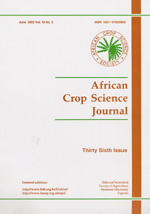
|
African Crop Science Journal
African Crop Science Society
ISSN: 1021-9730
EISSN: 1021-9730
Vol. 8, No. 1, 2000
|
 Bioline Code: cs00005
Bioline Code: cs00005
Full paper language: English
Document type: Research Article
Document available free of charge
|
|
|
African Crop Science Journal, Vol. 8, No. 1, 2000
| en |
Performance of Pigeonpea and its Finger Millet and Sorghum Intercrops
Rubaihayo, P.R.; Osiru, D.S.O. & Okware, P.
Abstract
Field trials were conducted to determine the optimum plant population and spatial
arrangement of finger millet/pigeonpea and sorghum/pigeonpea intercropping systems,
identify the intercrop compatibility of finger millet and sorghum with short- and
medium-duration pigeonpea, and evaluate insecticide application strategies for the control of
pod borers, pod sucking bugs and podfly on pigeonpea. The experiments were conducted at
Makerere University Agricultural Research Institute Kabanyolo (MUARIK) and Ngetta
experimental station during the second rains season of 1997 and first rains season of 1998.
Theoretical planting densities (2.1, 2.8, 4.2, 4.8, 5.6, 8.3, 11.1, and 16.7 plants m-2
) for pigeonpea, (8.3, 11.1, 16.7, and 33.3 plants m-2) for finger
millet and 5.6 plants m-2 for sorghum intercrops were studied using KAT
60/8, ICPL 87091 and ICP 6927 pigeonpea varieties, Pese 1 finger millet variety and
Seredo sorghum variety. Spraying against major pigeonpea insect pests was carried
out at vegetative stage, vegetative to pod maturity, flower bud initiation to pod formation,
and pod formation to pod maturity. In the pigeonpea/finger millet intercrop system, optimal
combinations in terms of higher land equivalent ratio (LER) values were given by 16.7 plants
m-2 of ICPL 87091 and 8.3 plants m-2 of Pese 1, 4.2
plants m-2 of KAT 60/8 and 33.3 plants m-2 of Pese
1. Planting of pigeonpea and finger millet or pigeonpea and sorghum in a 2:2 row
arrangement gave higher total LER values than in the other arrangements and thus, was
found to be an optimal row arrangement. Spraying pigeonpea cultivars ICPL 87091 and KAT
60/8 against major insect pests at flower bud initiation to pod formation and at pod formation
to pod maturity, respectively, produced significantly (P<0.05) better yields than unsprayed
and was more cost effective than the other spraying regimes.
Keywords
Cajanus cajan, insect pest management, intercropping, plant density, spatial arrangement, sole cropping, yield advantage
|
| |
| fr |
Rubaihayo, P.R.; Osiru, D.S.O. & Okware, P.
Résumé
Des essais ont été conduit pour détérminer la
densité optimale de population de plantes et larrangement spacial des
systèms dassociation et deleusine/pois dembrare et du sorgho/pois dembrare,
identifier la compatibilité de lassociation du eleusin le sorgho avec le pois
dembrave de courte et moyenne durée et évaluer de stratégies
dapplication dinsecticides pour le controle des boreurs de gousses, pucerons
suceurs de gousses et des podfly sur le pois dembrave. Les experiences ont
été conduites à lInstitut agricole Kabanyoro de
lUniversité de Makerere (MUARIK) et à la station experimentale de
Ngetta pendant la seconde saison de 1997 et dans al premier saison de plue de 1998. La
densité de plantation théoriques (2.1, 2.8, 4.2, 4.8, 5.6, 8.3, 11.1, et 16.7
plants par m-2) pour le pois dembrave, (8.3 11.1, 16.7 et 33.3 plants par
m-2) pour l'eleusine et 5.6 plants m-2 de sorgho en
association ont été étudiées utilisant les
variétés KAT 60/8, ICPL 87091 et ICP 6927 de pois dembrare,
Pese 1 deleusine et de la variété Seredo du sorgho. Le
traitment contre les principaux pests du pois dembrave a été fait au stade
végétatif, du stade régétatif à la maturité de
gousses, de linitition de la floraison à la formation de gousses, et de la formation
de gousse à la maturité de gousses. Dans le système dassociation
pois dembrave et leleusine, les combinaisons optimales en termes du rapport equivalent
de la terre (LER) les plus élevées ont été données
par la densité de 16.7 plantes m-2 pour la variété
ICPL 87091 et 8.3 plants m-2 pour Pese 1 et 4.2 plants m-2
pour KAT 60/8 et 33.3 plantes m-2 pour Pese 1. La
plantation du pois dembrave avec leleusine ou pois dembrave avec sorgho dans un
arrangement en lignes 2 à 2 a donné le rapports totale LER le plus
élevé plus que dautre arrangements, et il a été
Arouvé comme arrangement optimal en lignes. La pulverisation des cultivars ICPL
87091 et KAT 60/8 de pois dembrave contre les pestes de linitiation à la
formation de gousses et de la formation de gouses à la maturité ont produit
significativement de bons rendements plus que les traitements non pulverisés et
était plus rentable que dautres régimes dapplication.
Mots Clés
Pois cajan, gestion dinsecte nuisible, association, densité des plantes, arrangement spatial, culture en pure, avantage de rendement
|
| |
© Copyright 2000 - African Crop Science Society
|
|
